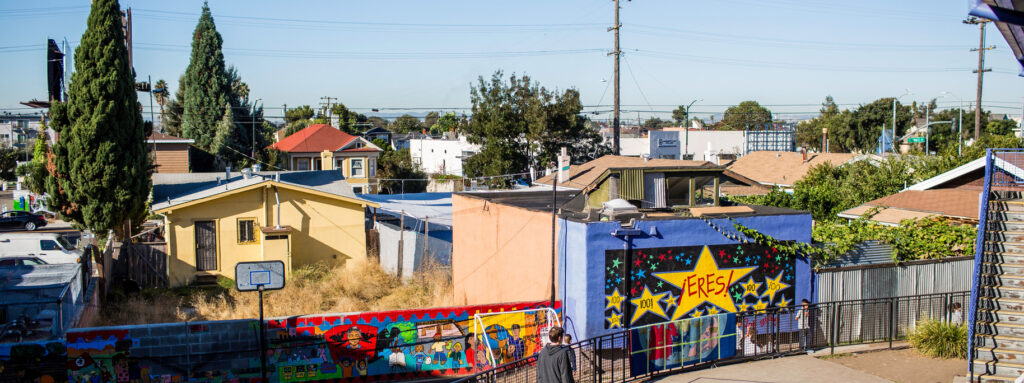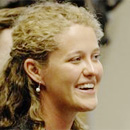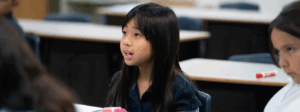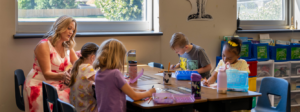Schools that truly prioritize authentic family and community engagement go far beyond parent-teacher conferences or special events. They make a real effort to learn about the unique context of their neighborhoods, listen to the perspectives of families and community members, involve community members in planning efforts, and collaborate with them to create a shared vision for supporting students.
To better understand what authentic community engagement can look like during the construction of a new campus, we sat down with Hrag Hamalian, Chief Executive Officer of Bright Star Schools, a network of eight, high-performing public charter schools serving three distinct communities in Los Angeles and Kerman Maddox, Managing Partner with Dakota Communications, a public affairs consulting firm specializing in community relations.
For 15 years, Bright Star’s Stella Middle Charter Academy has served kids in the West Adams, Baldwin Village and Crenshaw communities of South Los Angeles. Families have supported the school because it has done right by their children, providing an excellent public education. They’ve only had one gripe—while 95 percent of students served by Stella live in the local community, until recently, Bright Star wasn’t able to find a permanent school site in the neighborhood. This wasn’t due to lack of effort, but rather escalating costs and an incredibly competitive real estate market that favored residential and commercial projects over new schools.
This means that for 15 years, while fifth and sixth graders went to school at a church-school campus in West Adams, seventh and eighth graders have had to commute 45 minutes each day each way to a campus located near LAX. Hrag and Kerman shared the story of how they worked together to overcome this facilities challenge—and why community engagement made all the difference in finding Stella a permanent home in the community.
Hrag: We’ve always taken community engagement seriously at Bright Star. In the early years, we went attended neighborhood council meetings and community events to find parents and community stakeholders who were willing to work with us to shape a new school model that was right for their children. We had meetings with parents, kids, and staff every other week to make all kinds of key decisions, from operations to academics.
That level of back and forth meant that we grew slowly, and that was definitely the right choice because we were able to quickly respond to the needs of our families and communities. As we’ve grown into a network, we’ve had to be more strategic about authentic engagement with parents and communities. We now have parent engagement coordinators on staff who work directly with our families, multiple parent education and engagement opportunities, community breakfasts at school sites, and school site councils made up of community members who provide feedback on school-level decisions. Bright Star staff participate in local neighborhood council meetings, and we have three parent representatives on our board of trustees. We’re also keen on hiring staff from the communities we serve and who reflect the communities that we serve. 74 percent of our staff identify as people of color, reflecting the racially and ethnically diverse schools in our network.
But despite these efforts, we weren’t able to build strong relationships with community leaders in the West Adams, Baldwin Village, and Crenshaw communities—and we weren’t any closer to finding a permanent location for Stella Middle. We hadn’t done a good job of explaining who we were or what we were trying to do for students, and we decided it was about time that we owned that. So, we decided to work with Kerman to help us build better relationships with the community. Our first goal was to find out what people in the community thought about Bright Star and about our schools and to learn about their priorities. Then we could look for ways to work in true partnership to build a new campus.
Kerman: The thing to remember is that the Crenshaw, Baldwin Village, and West Adams communities have been hustled by a lot of people. They’re used to having people coming in and making big promises, and then not delivering. So, naturally, they’re suspicious. And you might have noticed—Hrag is not African-American. He looks different than most of the people in this community, that means the bar is higher. People have to believe he’s genuine. He has to win people over.
When we first met, Hrag and I had a very frank conversation. I told him that we’d be glad to work with him, provided he was actually serious about community engagement.
Hrag: I told Kerman I was totally on board. I know that real engagement is the key to long-term sustainability. You just can’t operate schools in a vacuum. You can’t assume that what you’ve seen in research works in a particular community. You need to listen to the community’s needs. You need to practice humility.
Kerman: To me, authentic engagement means going out into the neighborhood and listening to people. Meeting people where they are, under their circumstances. Sometimes that can feel uncomfortable for folks. You’re meeting at times that might be inconvenient. You’re at shopping centers, malls, churches, community centers, school gymnasiums, and the offices of elected officials.
But Hrag wasn’t intimidated. He showed up. He said yes to every meeting, no matter where it was or when it was, and then when he got there, he listened to what people said. He didn’t go into the community with pre-conceived notions. He didn’t say, “I’ve got all the answers. You just need to trust me and follow my lead. I’m going to be the savior of this community.”
After all, people can tell if you’re credible or not. Are you talking at them—trying to convince them you’re right—or are you talking to them and listening to their perspective? Hrag proved to be credible.
Hrag: We went into this process committed to listening. We never claimed to know everything. Instead, we wanted to be open and transparent, and find ways to give community stakeholders, parents, and kids a voice in the school system. So, we said yes to every meeting and did whatever we could to reach people.
Kerman: We started with the council office. They know the dynamics of the community. They know the pitfalls, and they know who is likely to support a project. Their staff members are in the streets every day, so they can save you a lot of time. Otherwise, you can twist in the wind thinking about who to talk to.
Hrag: At one point my staff and I ended up going door-to-door to reach people and introduce ourselves. We did a lot of activities to build relationships—a toy drive, a Thanksgiving food drive. Once I found myself in the middle of a mall over the holidays with a microphone in my hand, talking about Bright Star because that’s what I was asked to do. Some people might question the value of those different activities, but they were so important. People respond to goodwill. They needed to know that we cared. They needed to see that we were taking their feedback into account and taking action based on what they were telling us.
Kerman: I remember this tipping point, somewhere along the line, when we went from seeking out meetings with different community leaders to eventually seeing people in the community doing some of that outreach for us, setting up meetings on our behalf. People started calling their friends and co-workers, saying, “You need to be involved in this.”
Hrag: We ended up finding a local Baptist church in the area with a parcel of land for lease. The pastor wanted it to be purposed for educational use. Now, as we’re going through the building process, we want to make sure that we’re doing it with actual community integration. The church is going to run secular education programs like a STEM partnership with UCLA, afterschool programs, parent education programs, and literacy programs. We’re going to collaborate on community events, and are working on creating a community bidding process for the construction of the building, so that local sub-contractors can bid on the development and various aspects of the project.
Kerman: When you’re working hand-in-hand with the community, doors start opening. You start to see that you have common ground, that we’re stronger when we work together. No matter where people live, no matter what they look like, they want the best life for their kids.
Hrag: So often, because of urgency or stress, people can bulldoze past engagement. The ironic thing is if you take shortcuts when it comes to community engagement, you might get a school off the ground, but there’s no way that you can sustain it long-term. For real sustainability, authentic engagement is the only way forward.
Tips for Building Strong Relationships with Community Leaders
- Learn about the community’s unique history, landscape, and future growth patterns.
- Begin outreach with faith leaders, staff at local family-serving and youth-serving organizations, elected officials, and other leaders who understand the community. Consider working with a trusted liaison to help broker relationships and set up meetings. End every conversation with the question, “Who else should we be talking to?”
- Meet community members where they are, under their circumstances. Go to them—don’t ask them to come to you.
- Devote initial meetings to listening and building relationships. Build trust by taking action based on the feedback you are hearing.
- Build relationships that last by staying in contact, sharing progress, and looking for ways to support the community.








